Regional Scale Sea Cliff Hazard Assessment at Sintra and Cascais Counties, Western Coast of Portugal
Abstract
:1. Introduction
2. Setting
- (a)
- The Sintra massif rocks. These include granites with usually reddish orthoclase, which form the major part of the cliffs.
- (b)
- Southwards of Sintra massif, the sea cliffs are composed of a Jurassic series which includes compact limestones affected by contact metamorphism (Upper Oxfordian), carbonate schists with layers of marls and conglomerates (Upper Oxfordian–Lower Kimmeridgian), marly limestones, marls and limestones (Kimmeridgian–Portlandian), and nodular and compact limestones with some marl layers (Portlandian). These formations show a high (60° to 65°) dip to South and are cut by NW-SE wrench faults and numerous igneous dykes mostly trending NNW-SSE, N-S and E-W. The Portlandian formations contact by fault with Lower Cretaceous (Hauterivian-Lower Barremian) limestones and dolomitic limestones. These Mesozoic formations form the northern limb of a syncline which center is occupied by alternating marly limestones and marls (Albian-Middle Cenomanian) and is located southwards of Praia do Guincho. To South and East the cliffs are mainly composed by Cretaceous rocks, included in the following formations: Marly limestones and marls (Lower Hauterivian) limestones, dolomitic limestones and marls (Hauterivian-Lower Barremian), sandstones, marls and dolomite (Upper Barremian), limestones and marls (Lower Aptian), sandstones and clays (Upper Aptian) and alternating marly limestones and marls (Albian-Lower and Middle Cenomanian). The southwest and south coastal formations are cut by a large number of igneous dykes trending NNW-SSE to NNE-SSW, which outcrop at the cliffs, with variable weathering state. At the SW area, over the raised platforms that limit the top of the cliffs, there are deposits of Pleistocene raised beaches, Holocene cemented dunes and also Holocene mobile sand dunes, which do not form cliffs.
- (c)
- Northwards of Sintra massif, the sea cliffs are cut in a steeply northwards dipping beds sequence exposed along approximately 3.8 km of cliffs, which includes Jurassic marly limestones, marls and limestones (Kimmeridgian-Portlandian) compact and nodular limestones with marly interbedded layers (Portlandian), and Cretaceous limestones and marls (Berriasian), limestones and sandstones (Valanginian), marls and marly limestones (Lower Hauterivian), limestones (Hauterivian and Lower Barremian), sandstones with interbedded clays (Upper Barremian), which contacts by a thrust fault with sandstones and conglomerate with marly or clayey matrix, with interbedded clays (Oligocene).
3. Methods
3.1. Logistic Regression
3.2. Data Acquisition
3.1.1. Terrain Units
3.1.2. Inventory of Cliff Failures
3.1.3. Susceptibility Predisposing Factors
- (1)
- Major lithological units, including 10 classes: Basalt; Dolomitic limestones; Granitic rocks; Limestone, marls, basalt; Limestones; Limestones, marls; Marls, limestones; Marls, sandstones, limestones; Sandstones; Sandstones, limestones, marls.
- (2)
- Geological structure, i.e., bedding dip relation with the cliff face, including 6 classes: Bedding dip lower than 10° (Horizontal); Bedding dip directed towards the slope face (Against slope); Beds dip direction pointing outwards of the cliff face but dip lower than cliff face slope angle (Inferior to slope); Igneous rock masses with no visible structure (Massive); Beds dip direction roughly parallel to the cliff face with dip higher than 10° (Parallel to slope). Beds dip direction pointing seawards but with dip angle higher than the cliff face slope angle (Superior to slope).
- (3)
- Presence of faults (1) or without faults (0);
- (4)
- Presence and type of cliff toe protection in 8 classes: plunging cliffs with no protection; cliff toe protection by fallen blocks; wave cut platform; fallen blocks and platform; sandy or boulder beaches; beach and platform; beach and blocks; beach, blocks and platform.
- (5)
- Cliff height classified in a near quantile basis in 9 classes with height limits of 4, 12, 18, 26, 37, 48, 60, 72, 96 and 142 m.
- (6)
- Maximum cliff slope angle also in 9 quantile based classes with limits of 30, 52, 58, 62, 66, 69, 72, 75, 78 and 86°.
- (7)
- Mean cliff slope angle in 9 quantile based classes limits of 12, 26, 34, 40, 45, 49, 53, 58, 64 and 76°.
- (8)
- Standard variation of cliff slope angle in 7 quantile based classes with limits of 2.48, 6.8, 8.3, 9.7, 11.1, 12.6, 14.1 and 23.0°.
- (9)
- Aspect (direction of cliff face exposure) in the usual 8 classes: N, NE, E, SE, S, SW, W and NW.
- (10)
- Mean plan curvature of the cliff faces in 5 classes: highly concave, slightly concave, planar, slightly convex and highly convex.
- (11)
- Mean cross profile curvature of the cliff faces in 5 classes: highly concave, slightly concave, planar, slightly convex and highly convex.
- (12)
- The mean annual wave power data was computed from calibrated offshore wave hindcast modeling data for the period 1953–2009 [56] transposed near shore to the 10 m bathymetric line using the SWAN (version 40.72) wave model and existing bathymetry interpolated using a Triangulated Irregular Network (TIN), exported to a grid file using a linear interpolation. Model domain includes one regional grid, with a cell size of 1 km × 1 km, and another nested grid with finer mesh grid (cell size of 100 m × 100 m).
4. Results, Validation and Discussion
5. Conclusions
Supplementary Materials
Acknowledgments
Conflicts of Interest
References
- Trenhaile, A.S. Geomorphology of Rock Coasts; Clarendon Press: Oxford, UK, 1987; 384p. [Google Scholar]
- Sunamura, T. Geomorphology of Rocky Coasts; Wiley: New York, NY, USA, 1992; 302p. [Google Scholar]
- Moore, L.J.; Griggs, G.B. Long-term cliff retreat and erosion hotspots along the central shores of the Monterey Bay National Marine Sanctuary. Mar. Geol. 2002, 181, 265–283. [Google Scholar] [CrossRef]
- Emery, K.O.; Kuhn, G.G. Sea cliffs: Their processes, profiles and classification. Geol. Soc. Am. Bull. 1982, 93, 644–654. [Google Scholar] [CrossRef]
- Bird, E. Coastal Geomorphology: An Introduction; John Wiley and Sons: Chichester, UK, 2008; 436p. [Google Scholar]
- Marques, F.M.S.F. Sea cliff instability hazard prevention and planning: Examples of practice in Portugal. J. Coast. Res. 2009, 56, 856–860. [Google Scholar]
- Budetta, P.; De Luca, C. Wedge failure hazard assessment by means of a probabilistic approach for an unstable sea-cliff. Nat. Hazards 2015, 76, 1219–1239. [Google Scholar] [CrossRef]
- Bromhead, E.; Ibsen, M.-L. A review of landsliding and coastal erosion damage to historic fortifications in South East England. Landslides 2006, 3, 341–347. [Google Scholar] [CrossRef]
- Carrasco, A.R.; Ferreira, Ó.; Matias, A.; Dias, J.A. Historic monuments threatened by coastal hazards at Boca do Rio, Algarve, Portugal. Coast. Manag. 2007, 35, 163–179. [Google Scholar] [CrossRef]
- Teixeira, S.B. Coastal hazards from slope mass movements: Analysis and management approach on the Barlavento Coast, Algarve, Portugal. Ocean Coast. Manag. 2014, 102, 285–293. [Google Scholar] [CrossRef]
- Naylor, L.A.; Stephenson, W.J.; Trenhaile, A.S. Rock coast geomorphology: Recent advances and future research directions. Geomorphology 2010, 114, 3–11. [Google Scholar] [CrossRef]
- Marques, F.M.S.F.; Matildes, R.; Redweik, P. Sea cliff instability susceptibility at regional scale: A statistically based assessment in the southern Algarve, Portugal. Nat. Hazards Earth Syst. Sci. 2013, 13, 3185–3203. [Google Scholar] [CrossRef]
- Dong, P.; Guzzetti, F. Frequency-size statistics of coastal soft-cliff erosion. J. Waterw. Port Coast. Ocean Eng. 2005, 131, 37–42. [Google Scholar] [CrossRef]
- Marques, F.M.S.F. Magnitude-frequency of sea cliff instabilities. Nat. Hazards Earth Syst. Sci. 2008, 8, 1161–1171. [Google Scholar] [CrossRef]
- Lim, M.; Rosser, N.J.; Allison, R.J.; Petley, D.N. Erosional processes in the hard rock coastal cliffs at Staithes, North Yorkshire. Geomorphology 2010, 114, 12–21. [Google Scholar] [CrossRef]
- De Pippo, T.; Donadio, C.; Pennetta, M.; Petrosino, C.; Terlizzi, F.; Valente, A. Coastal hazard assessment and mapping in Northern Campania, Italy. Geomorphology 2008, 97, 451–466. [Google Scholar] [CrossRef]
- Del Río, L.; Gracia, F.J. Erosion risk assessment of active coastal cliffs in temperate environments. Geomorphology 2008, 112, 82–95. [Google Scholar] [CrossRef]
- Nunes, M.; Ferreira, Ó.; Schaefer, M.; Clifton, J.; Baily, B.; Moura, D.; Loureiro, C. Hazard assessment in rock cliffs at Central Algarve (Portugal): A tool for coastal management. Ocean Coast. Manag. 2009, 52, 506–515. [Google Scholar] [CrossRef]
- Milheiro-Oliveira, P. Bayesian statistical methods for modeling and prediction of major landslides in coastal areas. Coast. Eng. J. 2007, 49, 45–61. [Google Scholar] [CrossRef]
- Hapke, C.; Plant, N. Predicting coastal cliff erosion using a Bayesian probabilistic model. Mar. Geol. 2010, 278, 140–149. [Google Scholar] [CrossRef]
- Fall, M.; Azzam, R.; Noubactep, C. A multi-method approach to study the stability of natural slopes and landslide susceptibility mapping. Eng. Geol. 2006, 82, 241–263. [Google Scholar] [CrossRef]
- Martino, S.; Mazzanti, P. Integrating geomechanical surveys and remote sensing for sea cliff slope stability analysis: The Mt. Pucci case study (Italy). Nat. Hazards Earth Syst. Sci. 2014, 14, 831–848. [Google Scholar] [CrossRef]
- Castedo, R.; Fernández, M.; Trenhaile, A.S.; Paredes, C. Modelling cyclic recession of cohesive clay coasts: Effects of wave erosion and bluff stability. Mar. Geol. 2013, 335, 162–176. [Google Scholar] [CrossRef]
- Günther, A.; Thiel, C. Combined rock slope stability and shallow landslide susceptibility assessment of the Jasmund cliff area (Rügen Island, Germany). Nat. Hazards Earth Syst. Sci. 2009, 9, 687–698. [Google Scholar] [CrossRef]
- Young, A.P.; Flick, R.E.; Gutierrez, R.; Guza, R.T. Comparison of short-term seacliff retreat measurement methods in Del Mar, California. Geomorphology 2009, 112, 318–323. [Google Scholar] [CrossRef]
- Young, A.P.; Guza, R.T.; O’Reilly, W.C.; Flick, R.E.; Gutierrez, R. Short-term retreat statistics of a slowly eroding coastal cliff. Nat. Hazards Earth Syst. Sci. 2011, 11, 205–217. [Google Scholar] [CrossRef]
- Young, A.P. Recent deep-seated coastal landsliding at San Onofre State Beach, California. Geomorphology 2015, 228, 200–212. [Google Scholar] [CrossRef]
- Earlie, C.S.; Masselink, G.; Russell, P.; Shail, R. Application of airborne LiDAR to investigate rates of recession in rocky coast environments. J. Coast. Conserv. 2015, 19, 831–845. [Google Scholar] [CrossRef]
- Rosser, N.; Lim, M.; Petley, D.; Dunning, S.; Allison, R. Patterns of precursory rockfall prior to slope failure. J. Geophys. Res. 2007, 112. [Google Scholar] [CrossRef] [Green Version]
- Dewez, T.J.B.; Rohmer, J.; Regard, V.; Cnudde, C. Probabilistic coastal cliff collapse hazard from repeated terrestrial laser surveys: Case study from Mesnil Val (Normandy, northern France). J. Coast. Res. 2013, SI 65, 702–707. [Google Scholar] [CrossRef]
- Mancini, F.; Castagnetti, C.; Rossi, P.; Dubbini, M.; Fazio, N.L.; Perrotti, M.; Lollino, P. An Integrated Procedure to Assess the Stability of Coastal Rocky Cliffs: From UAV Close-Range Photogrammetry to Geomechanical Finite Element Modeling. Remote Sens. 2017, 9. [Google Scholar] [CrossRef]
- Barlow, J.; Gilham, J.; Cofrã, I.I. Kinematic analysis of sea cliff stability using UAV photogrammetry. Int. J. Remote Sens. 2017, 38. [Google Scholar] [CrossRef]
- Katz, O.; Mushkin, A. Characteristics of sea-cliff erosion induced by a strong winter storm in the eastern Mediterranean. Quat. Res. 2013, 80, 20–32. [Google Scholar] [CrossRef]
- Teixeira, S.B. Slope mass movements on rocky sea-cliffs: A power-law distributed natural hazard on the Barlavento Coast, Algarve, Portugal. Cont. Shelf. Res. 2006, 26, 1077–1091. [Google Scholar] [CrossRef]
- Barlow, J.; Lim, M.; Rosser, N.; Petley, D.; Brain, M.; Norman, E.; Geer, M. Modelling cliff erosion using negative power law scaling of rock falls. Geomorphology 2012, 139, 416–424. [Google Scholar] [CrossRef]
- Guzzetti, F.; Reichenbach, P.; Cardinali, M.; Galli, M.; Ardizzone, F. Probabilistic landslide hazard assessment at the basin scale. Geomorphology 2005, 72, 272–299. [Google Scholar] [CrossRef]
- Marques, F.M.S.F.; Matildes, R.; Redweik, P. Statistically based sea cliff instability hazard assessment of Burgau-Lagos coastal section (Algarve, Portugal). J. Coast. Res 2011, SI 64, 927–931. [Google Scholar]
- Antunes, C. Characterization of the Tide Regime. Deliverable 1.1.3.a. Project CISML, Portuguese Environment Agency (APA)—Faculty of Sciences, Univ. Lisbon, 2013. Available online: https://sniambgeoviewer.apambiente.pt/Geodocs/geoportaldocs/Politicas/Agua/Ordenamento/SistemasMonitorizacaoLitoral/E_1.1.3.a_Regime_mares.pdf (accessed on 14 October 2017).
- Silveira, T.M.; Taborda, R.; Andrade, C.F.; Silva, A.N.; Carapuço, A.M. Characterization of the Wave Regime near the coast. Deliverable 1.1.7.b. Project CISML, Portuguese Environment Agency (APA)–Faculty of Sciences, Univ. Lisbon, 2013. Available online: https://sniambgeoviewer.apambiente.pt/Geodocs/geoportaldocs/Politicas/Agua/Ordenamento/SistemasMonitorizacaoLitoral/E_1.1.7.b_Clima_agitao_costa.pdf (accessed on 14 October 2017).
- Kulberg, M.C.; Manuppella, G.; Rey, J.; Berthou, P.Y. Carta Geológica de Portugal, na Escala de 1:50 000, Folha 34-A (Sintra); LNEG: Lisbon, Portugal, 1991. [Google Scholar]
- Ramalho, M.M.; Pais, J.; Rey, J.; Berthou, P.Y.; Alves, C.A.M.; Palácios, T.; Leal, N.; Kullberg, M.C. Notícia Explicativa da Carta Geológica de Portugal, na Escala de 1:50 000, Folha 34-A (Sintra); LNEG: Lisbon, Portugal, 1993. [Google Scholar]
- Ramalho, M.M.; Ribeiro, M.L.; Serralheiro, A.; Almeida, F.M. Carta Geológica de Portugal, na Escala de 1:50 000, Folha 34-C (Cascais); LNEG: Lisbon, Portugal, 1999. [Google Scholar]
- Ramalho, M.M.; Rey, J.; Zbyszewski, G.; Alves, C.A.M.; Palácios, T.F.; Almeida, F.M.; Costa, C.; Kullberg, M.C. Notícia Explicativa da Carta Geológica de Portugal, na Escala de 1:50 000, Folha 34-C (Cascais); LNEG: Lisbon, Portugal, 2001. [Google Scholar]
- Hosmer, D.; Lemeshow, S. Applied Logistic Regression; Wiley: New York, NY, USA, 2000. [Google Scholar]
- Marques, F.M.S.F. A simple method for the measurement of cliff retreat from aerial photographs. Z. Geomorphol. 2006, 144, 39–59. [Google Scholar]
- Marques, F.M.S.F. Sea cliff evolution and related hazards in Miocene terranes of Algarve (Portugal). In Proceedings of the 7th International Congress of the International Association of Engineering Geology, Lisbon, Portugal, 5–9 September 1994; pp. 3109–3118. [Google Scholar]
- Marques, F.M.S.F. Sea cliff retreat in Portugal: Overview of existing quantitative data. In Proceedings of the 5th Congresso Nacional de Geologia, Lisbon, Portugal, 18–20 November 1998. [Google Scholar]
- Marques, F.M.S.F. Landslide activity in Upper Paleozoic shale sea cliffs: A case study along the western coast of the Algarve (Portugal). Bull. Eng. Geol. Environ. 2003, 62, 299–313. [Google Scholar] [CrossRef]
- Marques, F.M.S.F. Rates, patterns, timing and magnitude-frequency of cliff retreat phenomena. A case study on the west coast of Portugal. Z. Geomorphol. 2006, 144, 231–257. [Google Scholar]
- Marques, F.M.S.F.; Andrade, C. Discussion of: Dias, J.M.A. and Neal, W.J. Sea cliff retreat in southern Portugal: Profiles, processes, and problems. J. Coast. Res. 1993, 9, 1129–1135. [Google Scholar]
- Sobreira, F.G.; Marques, F.M.S.F. The relevance of sea cliff retreat assessment in hazard estimation: An example in the western coast of Portugal. In Proceedings of the International Congress of the International Association of Engineering Geology, Lisbon, Portugal, 5–9 September 1994; pp. 3119–3123. [Google Scholar]
- Borges, P.; Andrade, C.; Freitas, M.C. Dune, Bluff and Beach Erosion due to Exhaustive Sand Mining—The Case of Santa Barbara Beach, São Miguel (Azores, Portugal). J. Coast. Res. 2002, SI 36, 89–95. [Google Scholar]
- Marques, F.M.S.F. The Sea Cliffs of the Coast of Algarve. Dynamics, Processes and Mechanisms. Ph.D. Thesis, University of Lisbon, Lisbon, Portugal, 1997. [Google Scholar]
- Bezerra, M.M.; Moura, D.; Ferreira, Ó.; Taborda, R. Influence of Wave Action and Lithology on Sea Cliff Mass Movements in Central Algarve Coast, Portugal. J. Coast. Res. 2011, 27, 162–171. [Google Scholar] [CrossRef]
- Redweik, P.; Roque, D.; Marques, A.; Matildes, R.; Marques, F. Triangulating the past: Recovering Portugal aerial images repository. Photogramm. Eng. Remote Sens. 2010, 76, 1007–1018. [Google Scholar] [CrossRef]
- Dodet, G.; Bertin, X.; Taborda, R. Wave climate variability in the North-East Atlantic Ocean over the last six decades. Ocean Model. 2010, 31, 120–131. [Google Scholar] [CrossRef]
- Hoek, E. Practical Rock Engineering (2007 Edition). Available online: https://www.rocscience.com/learning/hoek-s-corner/books (accessed on 10 October 2017).
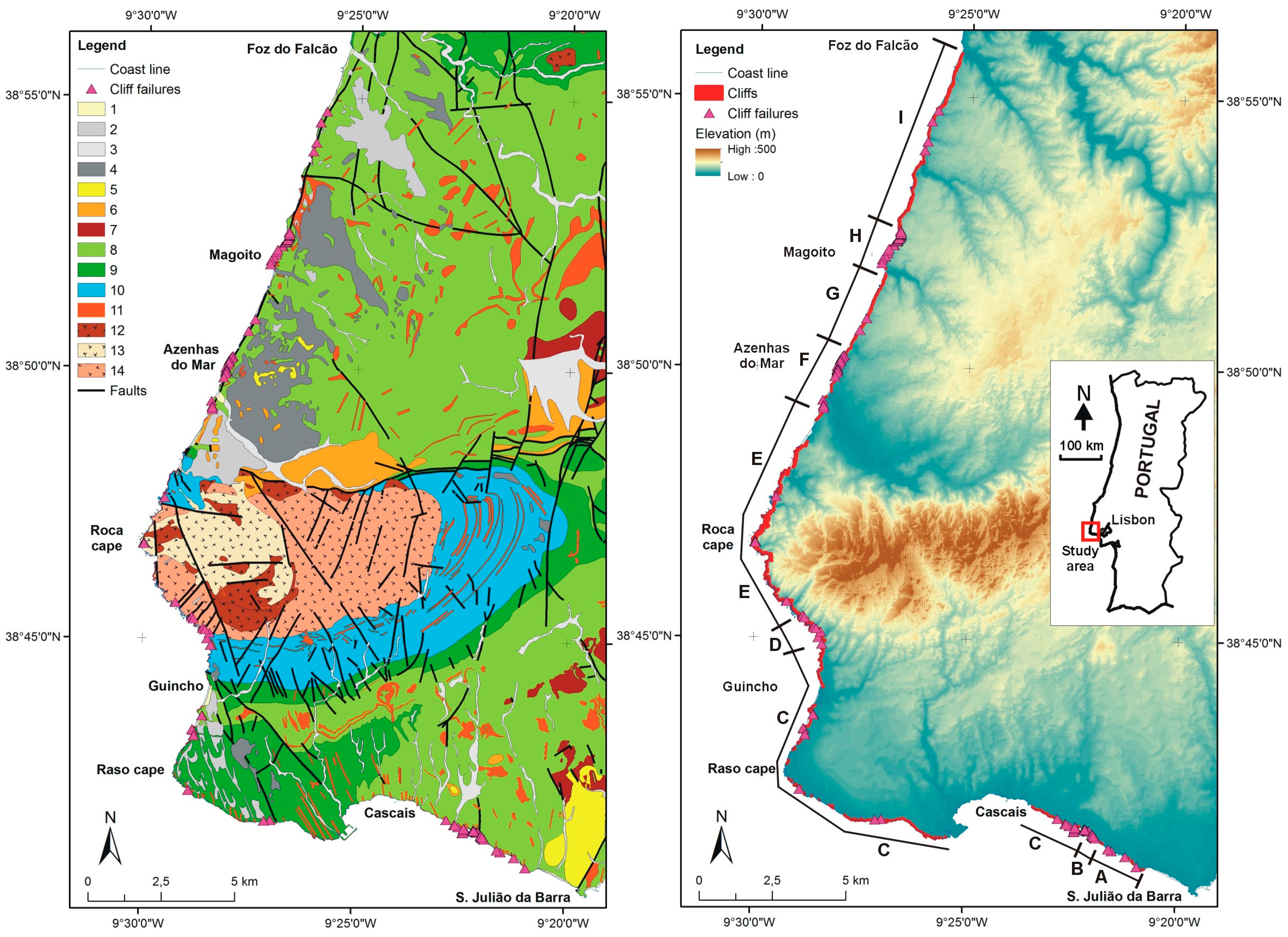
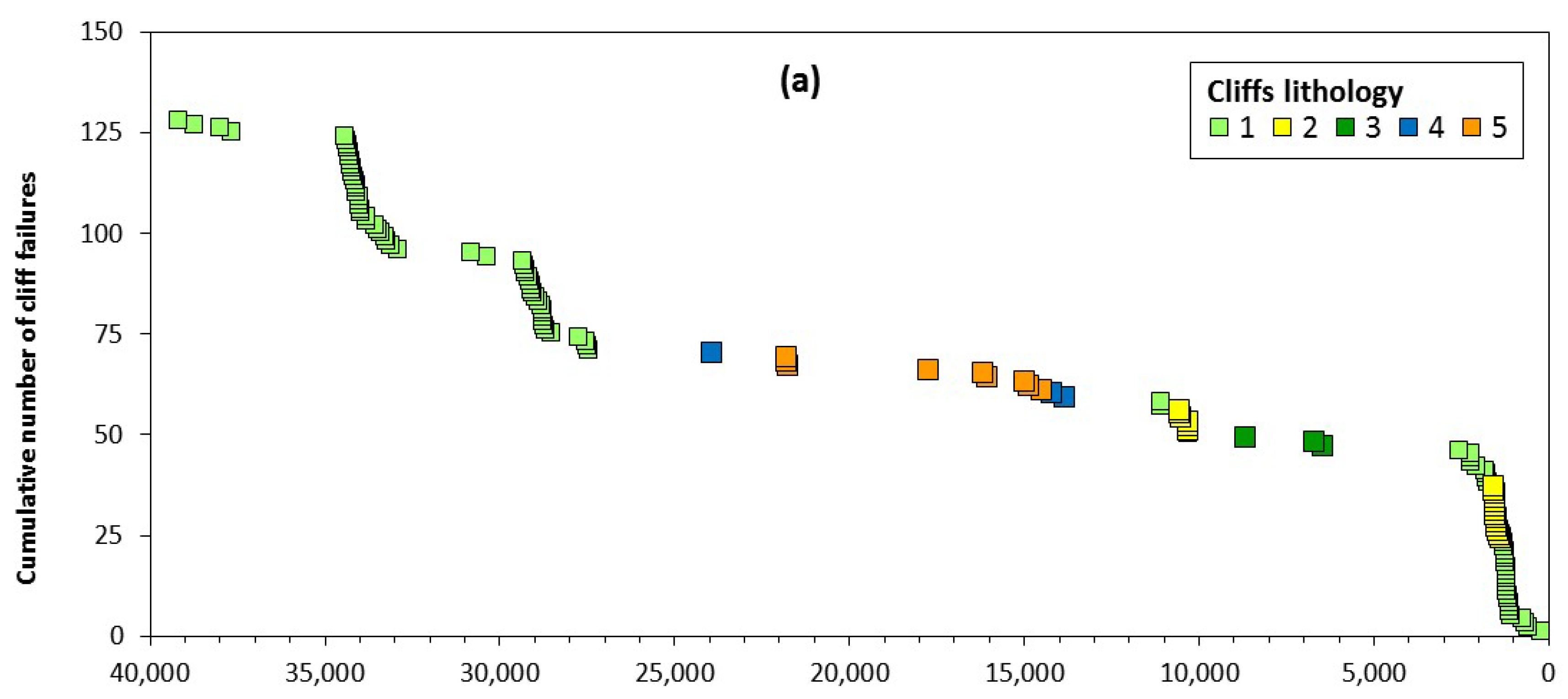
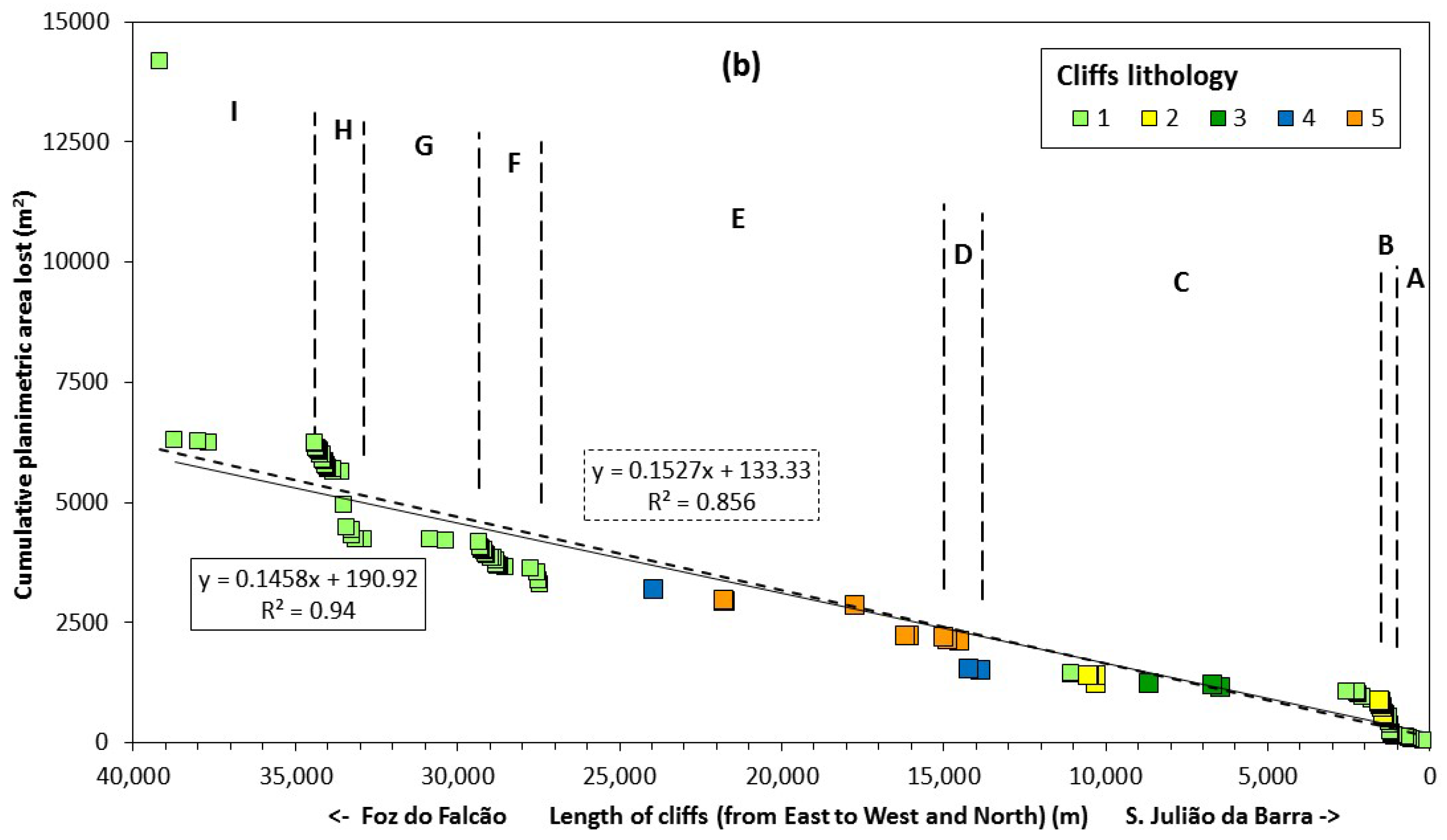
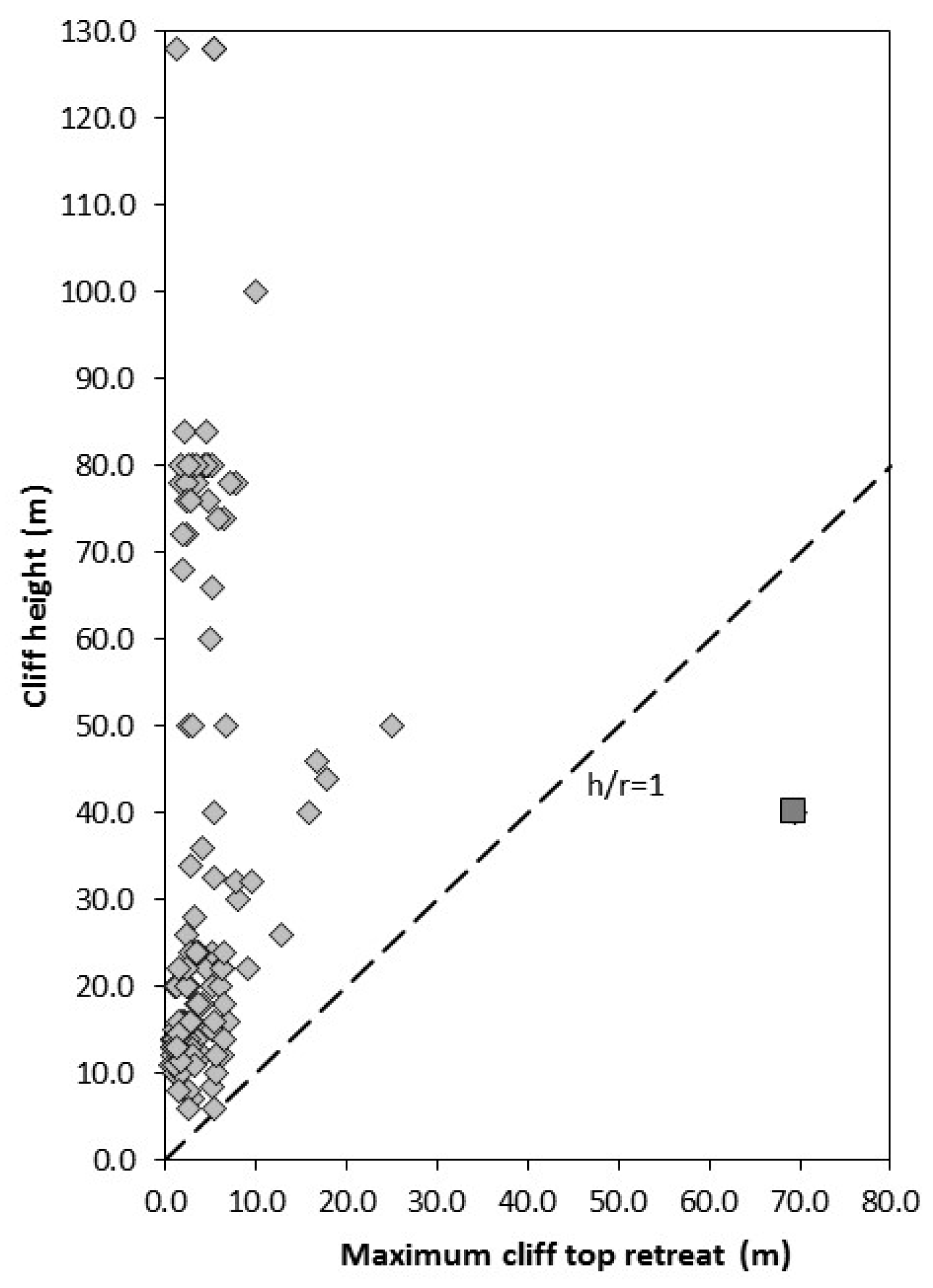


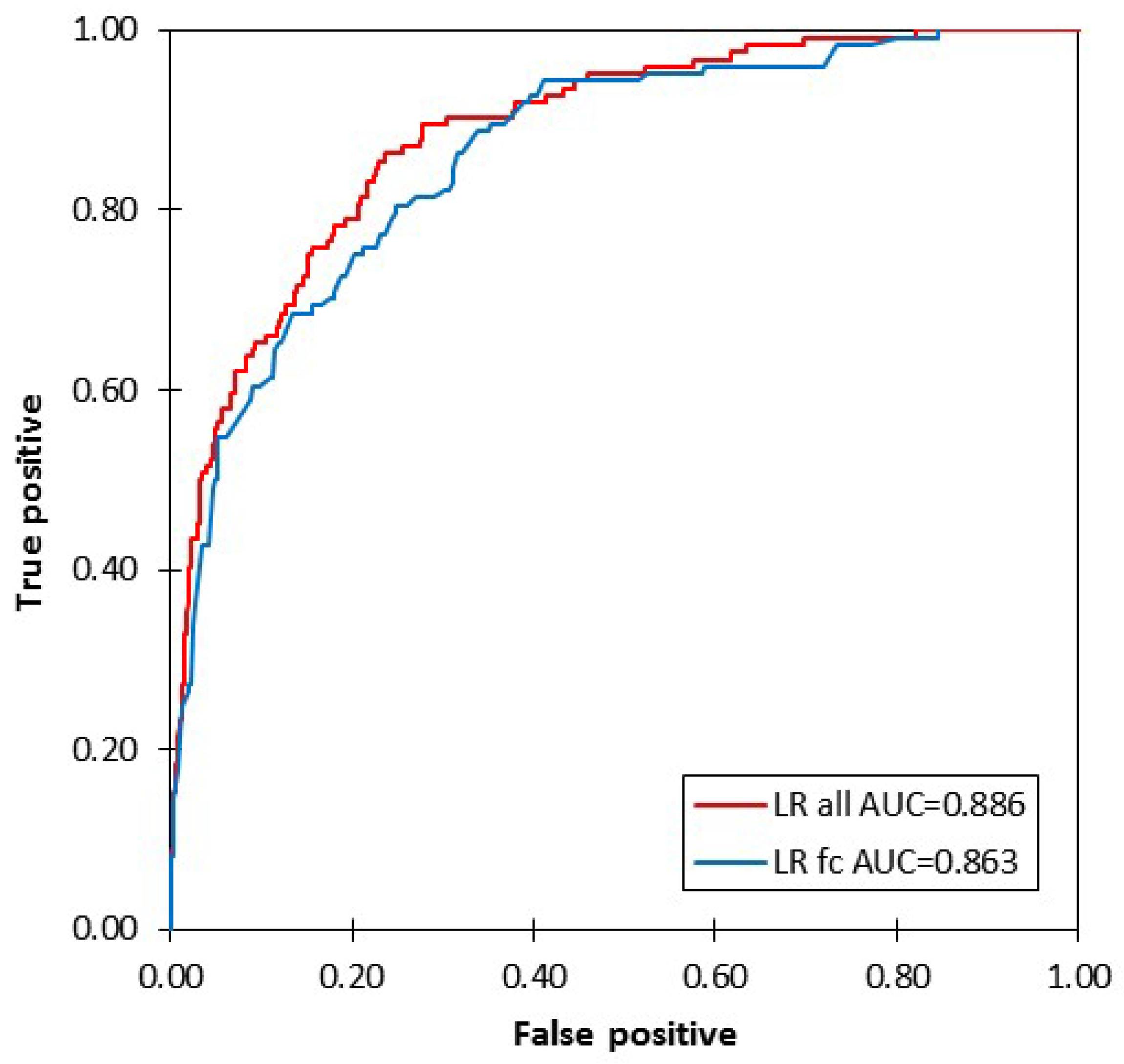
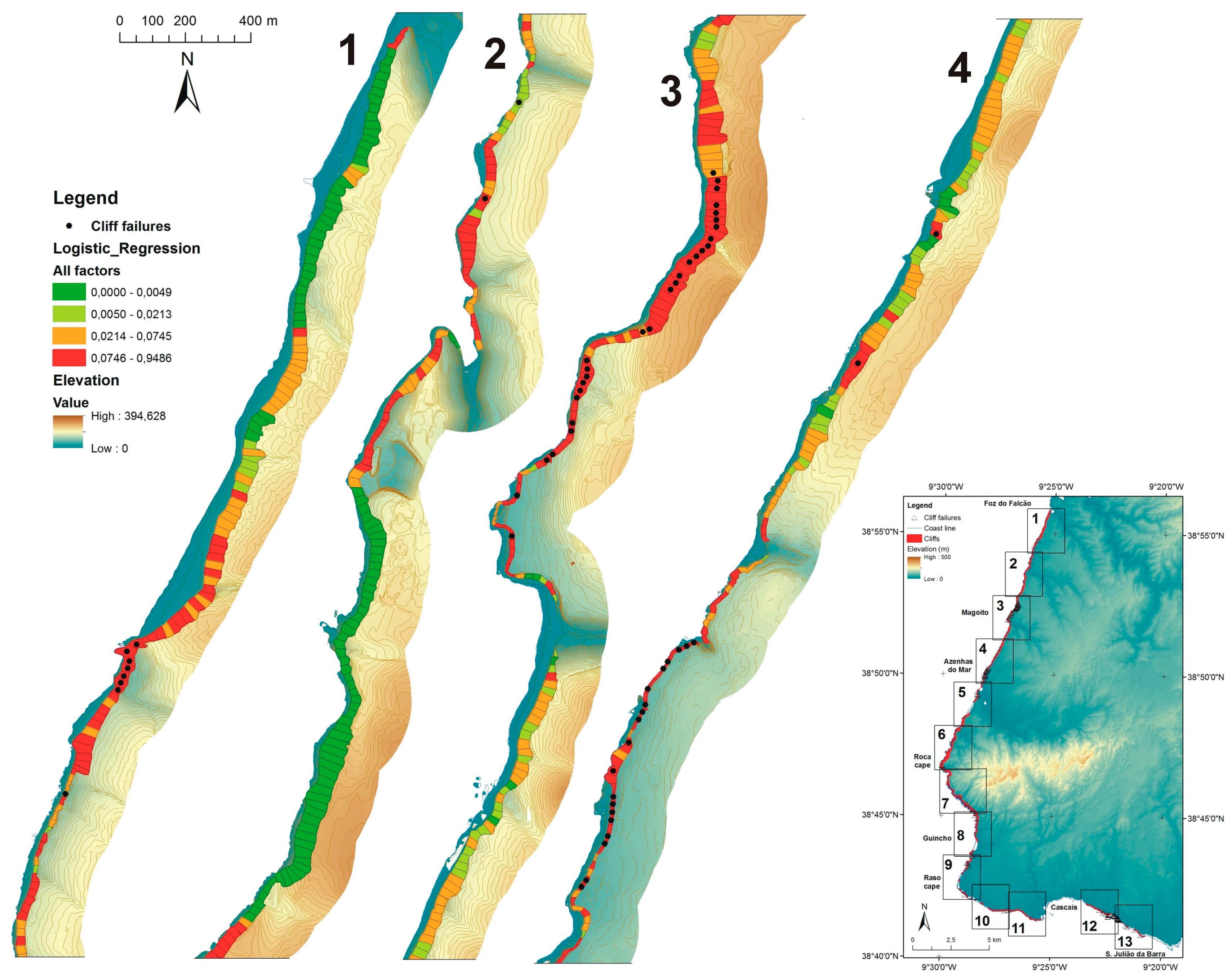
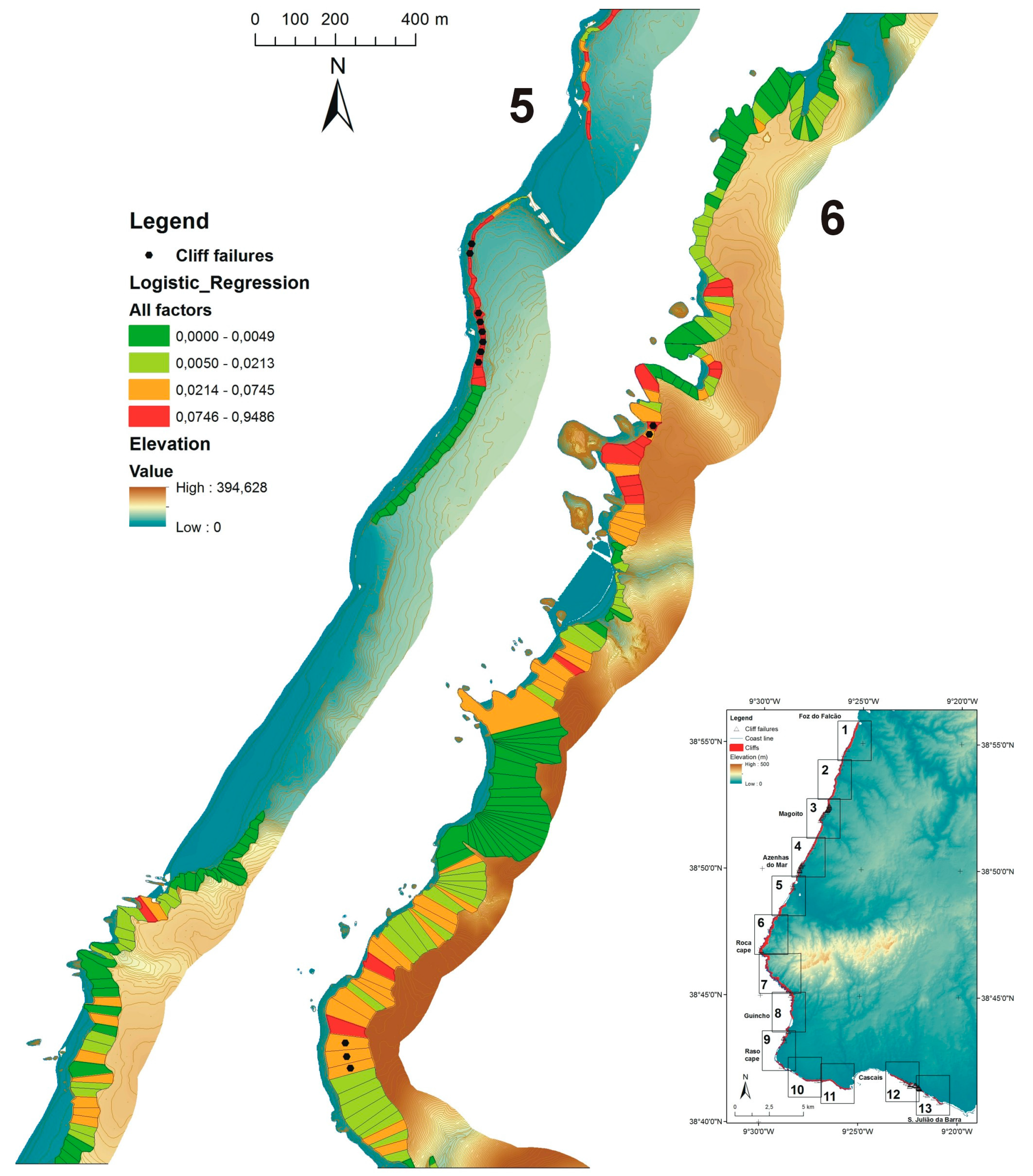
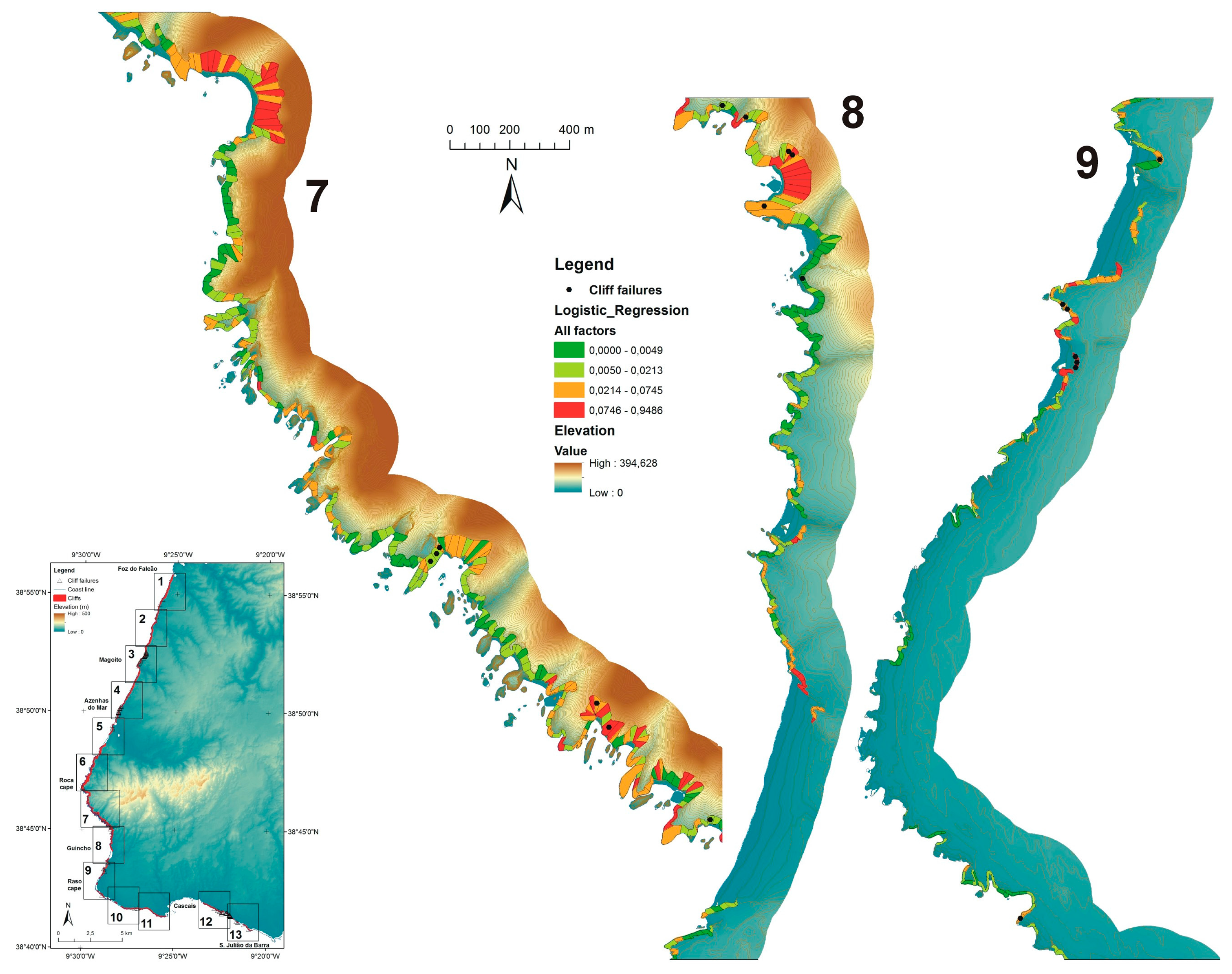
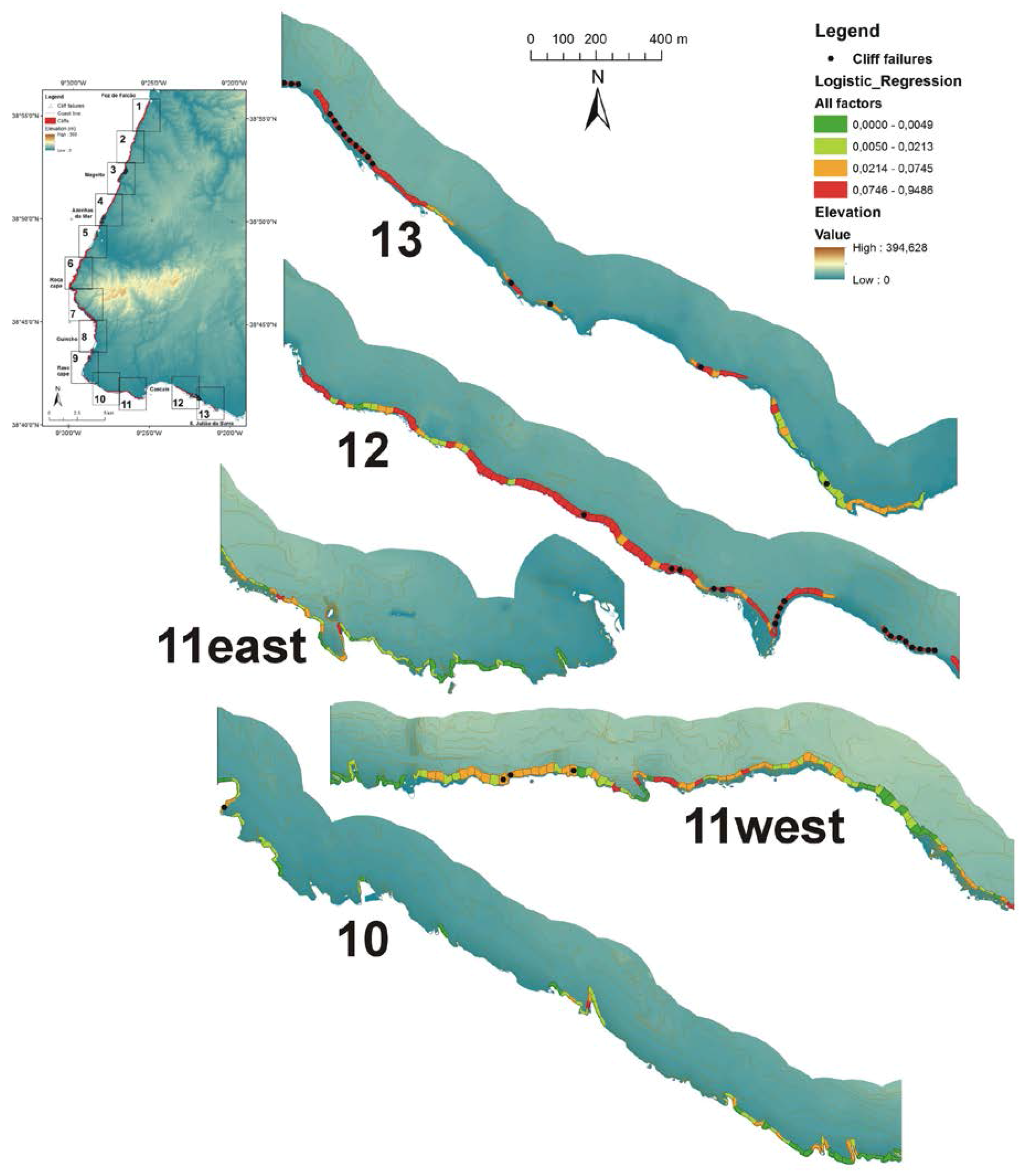
| Cliff Sectors | Linear Regression Slope | Retreat Rate (m/year) | Cliff Section Lenght (km) | |
|---|---|---|---|---|
| Beginning | End | |||
| Global | 0.1527 | 0.0024 | 0.00 | 41.45 |
| Without large landslide | 0.1458 | 0.0023 | 0.00 | 38.71 |
| Sector A | 0.106 | 0.0017 | 0.00 | 1.07 |
| Sector B | 1.7064 | 0.0271 | 1.07 | 1.50 |
| Sector C | 0.0493 | 0.0008 | 1.50 | 13.81 |
| Sector D | 0.6023 | 0.0096 | 13.81 | 14.97 |
| Sector E | 0.096 | 0.0015 | 14.97 | 27.42 |
| Sector F | 0.3349 | 0.0053 | 27.42 | 29.32 |
| Sector G | 0.0164 | 0.0003 | 29.32 | 32.89 |
| Sector H | 1.4859 | 0.0236 | 32.89 | 34.38 |
| Sector I | 0.0108 | 0.0002 | 34.38 | 38.71 |
| Factor | Variable | TUs | TUs with Cliff Failures | LR All Factors β | LR fw. Cond. β |
|---|---|---|---|---|---|
| Lithology | Sandstones, limestones, marls | 16 | 0 | - | - |
| Basalt | 22 | 0 | −2.299 | −2.615 | |
| Dolomitic limestones | 238 | 4 | 16.027 | 16.372 | |
| Granitic rocks | 369 | 12 | 15.156 | 15.386 | |
| Limestone, marls, basalt | 39 | 0 | −2.776 | −2.988 | |
| Limestones | 174 | 4 | 17.042 | 16.803 | |
| Limestones, marls | 463 | 62 | 17.610 | 17.549 | |
| Marls, limestones | 307 | 34 | 16.721 | 16.630 | |
| Marls, sandstones, limestones | 13 | 0 | 16.617 | 16.833 | |
| Sandstones | 17 | 8 | 19.954 | 19.572 | |
| Toe | None (plunging cliffs) | 558 | 14 | - | - |
| protection | Platform | 80 | 20 | 2.463 | 2.267 |
| Blocks | 588 | 60 | 1.168 | 1.033 | |
| Blocks, Platform | 83 | 15 | 0.938 | 1.049 | |
| Beach | 281 | 15 | 0.479 | 0.420 | |
| Beach, Platform | 6 | 0 | −16.958 | −17.134 | |
| Beach, Blocks | 57 | 0 | −17.036 | −17.534 | |
| Beach, Blocks, Platform | 5 | 0 | −17.830 | −17.331 | |
| Cliff height | 96–142 | 97 | 5 | - | - |
| 4–12 | 229 | 5 | −2.384 | −3.200 | |
| 12–18 | 198 | 25 | −1.658 | −1.512 | |
| 18–26 | 212 | 40 | −0.657 | −0.600 | |
| 26–37 | 174 | 8 | −2.268 | −2.411 | |
| 37–48 | 143 | 14 | −1.738 | −1.623 | |
| 48–60 | 225 | 5 | −2.433 | −2.584 | |
| 60–72 | 153 | 5 | −1.944 | −1.869 | |
| 72–96 | 227 | 17 | −0.305 | −0.343 | |
| Wave Power | 23,000–26,300 | 301 | 16 | - | - |
| 3200–6500 | 171 | 30 | 1.320 | 1.113 | |
| 6500–9800 | 123 | 3 | 0.172 | −0.130 | |
| 9800–13,100 | 143 | 7 | 2.303 | 2.480 | |
| 13,100–16,400 | 208 | 4 | 0.985 | 0.934 | |
| 16,400–19,700 | 323 | 33 | 1.993 | 1.805 | |
| 19,700–23,000 | 389 | 31 | 1.287 | 1.096 | |
| Structure | Superior to slope | 219 | 3 | - | - |
| Against slope | 26 | 6 | 2.029 | 2.641 | |
| Horizontal | 990 | 95 | 1.661 | 1.983 | |
| Inferior to slope | 7 | 6 | 5.959 | 5.696 | |
| Massive | 398 | 14 | 2.464 | 2.051 | |
| Parallel to slope | 18 | 0 | −16.742 | −16.282 | |
| Slope max. | 78–86 | 161 | 7 | - | - |
| 30–52 | 192 | 12 | 0.838 | - | |
| 52–58 | 176 | 13 | 1.002 | - | |
| 58–62 | 178 | 20 | 1.290 | - | |
| 62–66 | 203 | 19 | 1.026 | - | |
| 66–69 | 149 | 11 | 0.624 | - | |
| 69–72 | 190 | 4 | −0.620 | - | |
| 72–75 | 224 | 22 | 0.841 | - | |
| Slope max. | 75–78 | 185 | 16 | 0.605 | - |
| Aspect | NW | 462 | 33 | - | - |
| N | 79 | 2 | −0.799 | - | |
| NE | 16 | 0 | −17.887 | - | |
| E | 19 | 1 | 0.120 | - | |
| SE | 66 | 6 | 0.457 | - | |
| S | 190 | 10 | −0.229 | - | |
| SW | 329 | 25 | −0.092 | - | |
| W | 497 | 47 | 0.394 | - | |
| Plan | Highly convex | 78 | 10 | - | - |
| Curvature | Highly concave | 97 | 10 | −0.215 | - |
| Slightly concave | 231 | 14 | −0.852 | - | |
| Planar | 945 | 76 | −0.671 | - | |
| Slightly convex | 307 | 14 | −1.297 | - | |
| Profile | Highly convex | 89 | 12 | - | - |
| curvature | Highly concave | 251 | 26 | −0.776 | - |
| Slightly concave | 323 | 24 | −0.663 | - | |
| Planar | 783 | 48 | −0.828 | - | |
| Slightly convex | 212 | 14 | −0.787 | - | |
| Slope mean | 64–76 | 68 | 6 | - | - |
| 12–26 | 67 | 1 | −2.050 | - | |
| 26–34 | 163 | 16 | −0.373 | - | |
| 34–40 | 206 | 13 | −0.798 | - | |
| 40–45 | 222 | 14 | −0.856 | - | |
| 45–49 | 226 | 20 | −0.225 | - | |
| 49–53 | 265 | 21 | −0.196 | - | |
| 53–58 | 241 | 20 | −0.043 | - | |
| 58–64 | 200 | 13 | −0.852 | - | |
| Slope Stdv | 14.1–23.0 | 234 | 16 | - | - |
| 2.48–6.8 | 238 | 15 | −1.320 | - | |
| 6.8–8.3 | 234 | 13 | −0.970 | - | |
| 8.3–9.7 | 251 | 21 | −0.684 | - | |
| 9.7–11.1 | 230 | 15 | −0.623 | - | |
| 11.1–12.6 | 235 | 23 | −0.430 | - | |
| 12.6–14.1 | 236 | 21 | −0.179 | - | |
| Faults | Fault | 196 | 11 | 0.474 | - |
| Constant | ε | - | - | −20.553 | −21.706 |
| Factor | AUC | Lower LimitInt. Conf. 95% | Upper LimitInt. Conf. 95% |
|---|---|---|---|
| Lithology | 0.728 | 0.688 | 0.768 |
| Toe protection | 0.716 | 0.671 | 0.76 |
| Cliff height | 0.715 | 0.67 | 0.76 |
| Wave Power | 0.669 | 0.622 | 0.717 |
| Structure | 0.662 | 0.617 | 0.707 |
| Slope max | 0.608 | 0.56 | 0.656 |
| Aspect | 0.571 | 0.521 | 0.621 |
| Plan curvature | 0.571 | 0.52 | 0.623 |
| Profile curvature | 0.569 | 0.514 | 0.623 |
| Slope mean | 0.562 | 0.511 | 0.613 |
| Slope STD | 0.558 | 0.506 | 0.611 |
| Faults | 0.516 | 0.464 | 0.586 |
© 2018 by the author. Licensee MDPI, Basel, Switzerland. This article is an open access article distributed under the terms and conditions of the Creative Commons Attribution (CC BY) license (http://creativecommons.org/licenses/by/4.0/).
Share and Cite
Marques, F. Regional Scale Sea Cliff Hazard Assessment at Sintra and Cascais Counties, Western Coast of Portugal. Geosciences 2018, 8, 80. https://doi.org/10.3390/geosciences8030080
Marques F. Regional Scale Sea Cliff Hazard Assessment at Sintra and Cascais Counties, Western Coast of Portugal. Geosciences. 2018; 8(3):80. https://doi.org/10.3390/geosciences8030080
Chicago/Turabian StyleMarques, Fernando. 2018. "Regional Scale Sea Cliff Hazard Assessment at Sintra and Cascais Counties, Western Coast of Portugal" Geosciences 8, no. 3: 80. https://doi.org/10.3390/geosciences8030080





